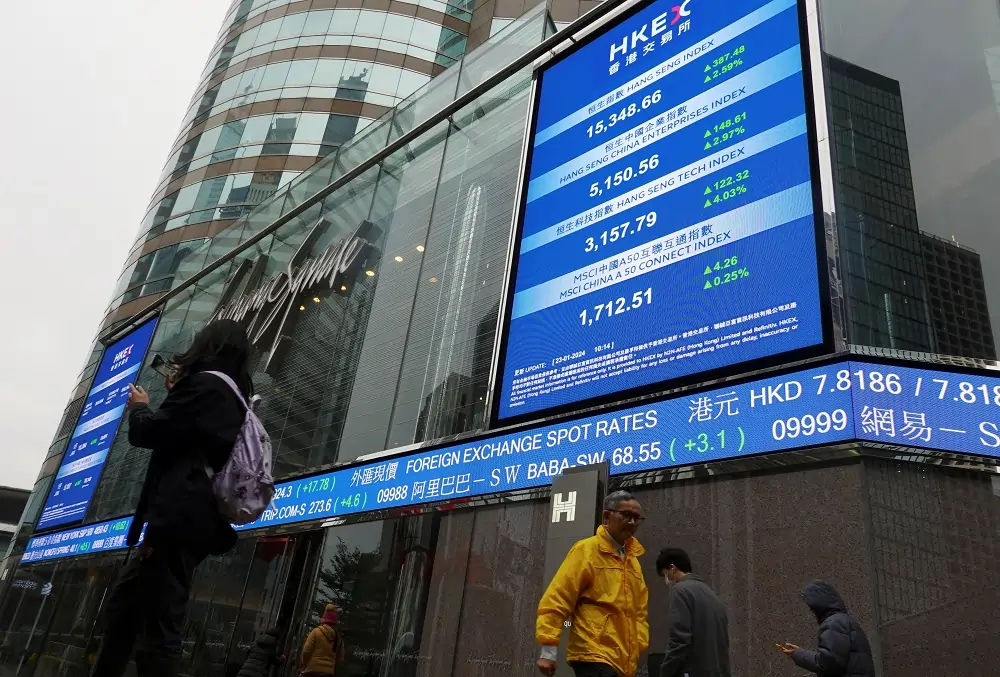
Stocks, dollar slip ahead of Fed decision on rates
By Herbert Lash and Tom Wilson
NEW YORK/LONDON (Reuters) -World shares slipped on Wednesday, pulled lower by a slide on Wall Street, while Treasury prices rose as investors deemed the U.S. economy was headed toward a soft landing hours before the Federal Reserve concludes its two-day policy meeting.
Investors hope to glean clues and further insight on when the Fed starts to cut interest rates, with futures suddenly shifting bets to favoring a March cut at a 63% probability, according to the CME Group’s FedWatch Tool.
The dollar dipped against the euro and yen as traders awaited the Fed’s statement at 2 p.m. ET (1900 GMT) and Chair Jerome Powell’s press conference 30 minutes later. The U.S. central bank is expected to hold rates steady, but flag future cuts by dropping language suggesting further hikes.
“Powell will be walking a tightrope in terms of policy from here because the U.S. economy is about as good as it gets, and frankly, at this point what they’re trying to do is to not screw it up,” said Matt Miskin, co-chief investment strategist for John Hancock Investment Management in Boston.
“It’s this balancing act for the Fed where you don’t want to have the economy so strong that it re-accelerates inflation or causes it to come back,” he said. “But you also want to be mindful that if inflation is coming down to your target, you don’t need to be overly restricted.”
European shares, meanwhile, rose slightly, with the pan-regional STOXX 600 index up 0.16%, lifted by robust corporate updates and strong market performances in Spain and Italy.
But MSCI’s gauge of stocks across the globe shed 0.44% and Wall Street wallowed, with the tech-rich Nasdaq tumbling 1.61% to a week’s low as Google-parent Alphabet’s projections for rising AI costs slammed most megacap and chip stocks.
The outsized weighting of so-called Magnificent Seven stocks in the S&P 500 is under renewed focus from investors, even as their collective strength has pushed the benchmark index to record highs this month.
Treasury yields dived as investors bid up prices, which move inversely to their yield, on signs of slowing labor costs and a weaker than expected reading of private payrolls. Data painting a resilient economy had forced prices lower on fears the Fed would not cut rates anytime soon.
The two-year Treasury yield, which reflects interest rate expectations, fell 15.4 basis points to 4.205%, while the yield on the benchmark 10-year note was down 10.5 basis points at 3.952%.
The dollar index has gained almost 2% against a basket of major currencies this month, its biggest rise since September, as markets dialed back expectations on the speed and scale of rate cuts. It was last down 0.28% at 103.09.
Euro zone government bond yields dropped after mixed economic data from Germany and France, and dovish comments from European Central Bank officials.
Germany’s 10-year government bond yield, the benchmark for the euro area, fell 9.7 basis points to 2.177%.
Other market moves were largely subdued as traders stayed on guard ahead of the Fed decision.
Earlier Chinese shares lost 0.9% after a survey showed manufacturing activity shrinking in January for a fourth month.
That dragged MSCI’s broadest index of Asia-Pacific shares outside Japan down 0.4%, and it was heading for a monthly loss of roughly 5%, snapping a two-month winning streak.
China’s blue-chip index, which earlier this month hit its lowest since 2019, lost 0.9% and is down roughly 6% for January, marking its sixth straight monthly decline – a record losing streak.
In Japan though, the Nikkei ended the month with a more than 8% gain, its best January performance since 1998.
The yen strengthened 0.87% at 146.31 per dollar and was on course for a monthly decline of 4.5%, which would be its largest monthly drop since June 2022.
Oil prices fell, pressured by lackluster economic activity in leading crude importer China, but a first monthly gain since September remained in sight as flaring tensions in the Middle East heightened supply concerns.
U.S. crude fell 2.29% to $76.04 per barrel and Brent was at $81.77, down 1.33% on the day.
(Reporting by Herbert Lash, additional reporting by Tom Wilson in London; Rae Wee in Singapore; Editing by Edmund Klamann, Shri Navaratnam, Tomasz Janowski, Jan Harvey and Alexander Smith)


